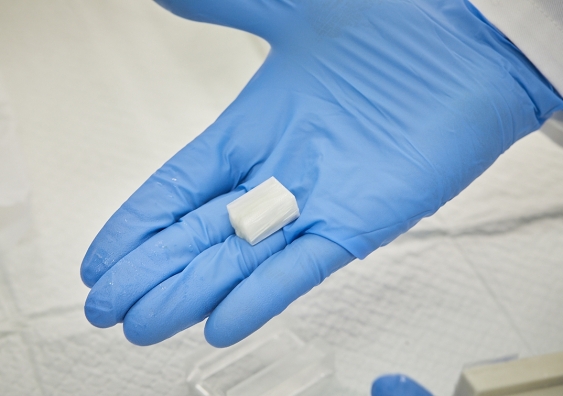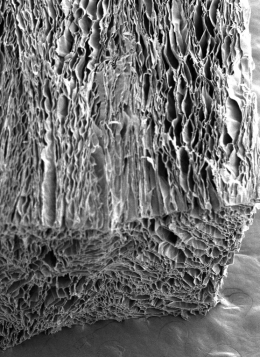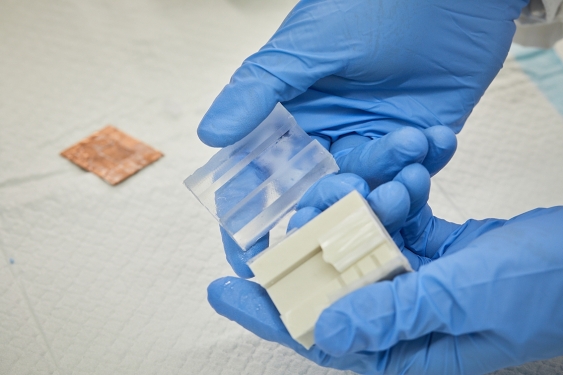创新背景
丝是一种非常适合心脏贴片的生物材料——作为健康心脏干细胞附着和生长的材料。
心脏贴片背后的想法是在实验室中生长心脏组织,使用丝绸作为支架,训练孤立的心脏干细胞以模仿天然组织的方式生长,以取代患者心脏中的疤痕组织。其中一个挑战是让细胞以高度组织,对齐的心肌方式排列自己。
创新过程
研究人员使用3d打印机用硅制作定制模具。接着,把丝绸和水的溶液倒入模具,然后把它放在一个用干冰冷却的铜板上。慢慢地,丝绸溶液中的水开始变成冰,从模具底部向一个方向稳定地冻结,直到它到达溶液的顶部。
在冷冻干燥冷冻丝绸块后,研究人员有效地剥去了上面的冰,留下了沿着单一方向延伸的细长毛孔。蚕丝的结构和冰晶的结构完全一致,结果证明这和心肌的微观结构非常相似。

从硅模具中取出的丝块
通过简单地控制里面的水冻结来控制丝绸支架的结构。这使研究人员能够在支架中为这些非常复杂的结构创建一个模板,从而控制细胞的行为。冷冻过程的一个关键部分是水逐渐变成冰,向一个方向流动,而不是像传统冰箱那样从各个方向流动。

加工过的蚕丝的电子显微镜图像显示细长的孔隙,非常适合播种心脏干细胞
丝绸是一种蛋白质。当冰开始在丝溶液中生长时,这种蛋白质就会聚集在生长的冰周围,当冰向上移动时,它会把这种蛋白质推开。当它完全结冰时,你可以把它冷冻干燥,这样就可以去除冰。所以你最终会得到一些毛孔,这些毛孔是曾经是冰的丝绸上的负面铸件。
这看起来很简单,但时间、温度和冷冻速度是构建具有正确形状和结构的毛细孔的丝的关键,这将允许心肌细胞的生长。

硅模具打开,露出冰冻的丝绸结构
如果改变了冰的结构,也就改变了留下的丝结构的孔隙形态。要改变冰的结构,则只需要改变结冰的速度,使用的丝的数量或使用的丝的类型,因为每种形式的结冰不同,导致不同的孔隙形态。例如,通过添加更多的蚕丝使毛孔变宽,通过冷冻较少的蚕丝使毛孔变细,或者通过冷冻不同类型的蚕丝使毛孔变圆。
创新关键点
研究人员使用3d打印机用硅制作定制模具。接着,把丝绸和水的溶液倒入模具,然后把它放在一个用干冰冷却的铜板上。慢慢地,丝绸溶液中的水开始变成冰,从模具底部向一个方向稳定地冻结,直到它到达溶液的顶部。
通过简单地控制里面的水冻结来控制丝绸支架的结构。这使研究人员能够在支架中为这些非常复杂的结构创建一个模板,从而控制细胞的行为。冷冻过程的一个关键部分是水逐渐变成冰,向一个方向流动,而不是像传统冰箱那样从各个方向流动。
创新价值
研究人员对冷冻丝溶液的研究和对不同生物材料结构的实验将使其成为比目前生物医学实验室中可用的更便宜和更容易实现的过程。它还可以用来创建人体其他组织结构的不同模板。
Innovative use of 'frozen silk' could help repair damaged hearts
The researchers used a 3D printer to create custom molds in silicon. Next, a solution of silk and water is poured into the mold and placed on a copper plate cooled with dry ice. Slowly, the water in the silk solution begins to turn into ice, freezing steadily in one direction from the bottom of the mold until it reaches the top of the solution.
After freeze-drying the frozen silk blocks, the researchers effectively stripped the ice from them, leaving elongated pores extending in a single direction. The structure of silk is exactly the same as the structure of ice crystals, which turns out to be very similar to the microstructure of heart muscle.
Control the structure of the silk scaffold by simply controlling the water inside to freeze. This allowed the researchers to create a template for these very complex structures in the scaffold to control the behavior of the cells. A key part of the freezing process is that the water gradually turns into ice and flows in one direction, rather than in all directions as in a traditional refrigerator.
Silk is a protein. When the ice begins to grow in the silk solution, the protein gathers around the growing ice, and as the ice moves upward, it pushes the protein away. When it's completely frozen, you can freeze dry it, which will remove the ice. So you end up with pores that are negative castings on silk that used to be ice.
It may seem simple, but time, temperature, and freezing rate are key to building filaments with pores of the right shape and structure that will allow cardiomyocytes to grow.
If you change the structure of the ice, you change the pore shape of the silk left behind. To change the structure of ice, you only need to change the rate of icing, the amount of silk used, or the type of silk used, because each form of icing is different, resulting in different pore morphology. For example, make pores wider by adding more silk, narrow them by freezing less silk, or round them by freezing different types of silk.
智能推荐
生物医学工程创新 | 利用CRISPR标记可将干细胞转化为所需细胞类型
2022-09-30杜克大学的一个生物医学工程师团队通过掌握基因调节网络的语言,创造了一种将干细胞转化为所需细胞类型的新方法。
涉及学科涉及领域研究方向细胞学创新 | 创新开发”M-CREATE法”可快速识别AAV变体
2022-10-27研究人员开发了一种方法,可以快速有效地识别设计腺相关病毒(AAV)变体,这种病毒可以传递到或“转导”小鼠特定类型的细胞,使科学家能够根据研究或临床需要选择一种病毒。
涉及学科涉及领域研究方向新材料 | 开发新型生物材料可加速身体自愈过程
2022-09-29研究团队为外科医生设计了一种绷带,植入骨折部位可加速自然愈合过程。
涉及学科涉及领域研究方向生物医学工程创新 | 利用活细胞构建“半互穿聚合物网络”使药物输送更安全
2022-09-30杜克大学的生物医学工程师已经证明了一种被称为半互穿聚合物网络的交织复合材料可以由活细胞产生。
涉及学科涉及领域研究方向